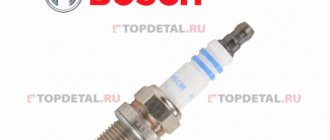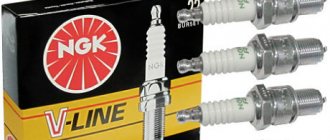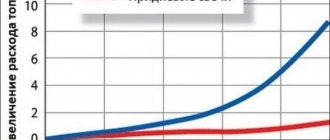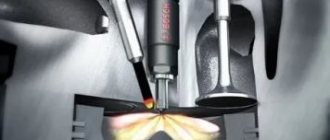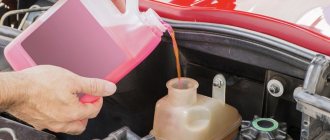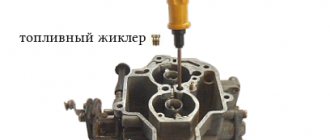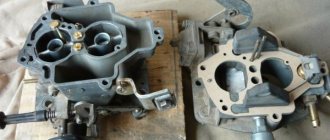In injection and carburetor gasoline engines, the spark to ignite the fuel mixture is supplied through the spark plug. At first glance, it seems that there are no special requirements for such a part, but when visiting a specialized store, a car enthusiast will see a wide range of spark plugs, differing from each other in various parameters.
Features of SZ
Spark plugs sold in automotive stores differ in various parameters:
- Manufacturer: Bosch, NGK, Brisk and others.
- Design - single or multi-electrode.
- Heat number.
- Spark gap.
- The metal from which the electrodes are made is copper alloy, platinum, iridium.
- Connecting dimensions - size of the threaded part, thread pitch, hexagon wrench size.
In short, without special knowledge it is very difficult to select spark plugs. Spark plug markings and interchangeability tables can help in this matter. For example, the VAZ-2105 produces domestic spark plugs A17DV, which correspond to spark plugs from other manufacturers: L15Y from Brisk, BP6ES from NGK, W7DC from Bosch and 64 from Autolite. In fact, the same candle is labeled differently by different manufacturers. What the markings on spark plugs mean and how to understand them will be discussed below.
NGK candles: how to spot a fake
As you know, the wide popularity and reputation of a quality brand often makes such a manufacturer the object of unfair competition, and also becomes a reason for the production of a large number of low-quality counterfeits. As for spark plugs, the percentage of non-original counterfeit products in this segment is very high, especially in the CIS markets.
Just a few years ago, such counterfeits were much easier to detect. The non-original product was clearly indicated:
- low quality packaging;
- lack of protective holographic stickers;
- blurry/crooked fonts on the packaging and labeling of the candle;
- suspiciously low price and a number of other signs;
The spark plugs themselves were also handmade; there were jagged marks on the edges of the electrodes, cuts and edges could be crooked, the markings on the spark plugs differed in quality and type of font, sealing washers were loose, etc.
Please note that if we look at NGK spark plugs today, the fake and the original can be very similar in appearance. The current situation is such that, as a rule, consumers (even with some experience), upon detailed study and careful examination, have great difficulty distinguishing an original product from a copy or do not see any differences at all. The reason is that the quality of printing and the manufacturing counterfeit products
Moreover, with such spark plugs, the engine can operate tolerably without obvious failures and problems for more than one thousand or even tens of thousands of kilometers.
The reason is that the quality of printing and the production of counterfeit products has noticeably improved. Moreover, with such spark plugs, the engine can operate tolerably without obvious failures and problems for more than one thousand or even tens of thousands of kilometers.
However, this does not mean that the fake is significantly closer in quality and performance to the original. Research and tests conducted in laboratory conditions using special equipment clearly demonstrate the harmfulness of using such spark plugs for the internal combustion engine and the driver’s wallet.
In view of the above, it is strongly recommended that you purchase spark plugs from NGK and other well-known brands (DENSO, BOSH, etc.) only from authorized sales points. It is also advisable to follow updates and changes that, for obvious reasons, are specifically introduced by manufacturers themselves to protect their products at certain intervals.
Spark plugs of Russian brands
The marking of spark plugs produced by domestic manufacturers is regulated by the OST 37.003.081 standard. Spark plug markings are deciphered using individual letters and numbers. For example, the body thread is indicated by the first letter. Under the letter A lies M14 x 1.25 - a standard size typical for a regular spark plug. The marking of candles in the form of the letter M implies a threaded size of M18 x 1.5 - the threaded part of such a candle is larger and fits a 27 wrench.
Immediately after the letters there is a number indicating the heat value: the lower it is, the higher the temperature the spark is knocked out. The heat index of spark plugs produced in Russia varies from 8 to 26. The most common are 11, 14 and 17 spark plugs. The marking of spark plugs according to their heat divides them into cold and hot. The first ones are installed on highly accelerated engines.
Below is an example of what spark plug markings may be and how to decipher them. Spark plugs A17DV:
- classic carving;
- 17 - heat number;
- the size of the threaded part D is 9 millimeters; if this parameter is less, then the letter is simply not specified;
- The letter B usually denotes a protruding type of insulator thermal cone.
The presence of the letter P in the marking - A17DVR - means that there is an interference suppression resistor in the central electrode. The letter M in the marking indicates the use of heat-resistant copper material to create the shell of the central electrode.
In the case of the designation AU17DVRM, the letter U stands for an increased hexagon size - 16 instead of the standard 14 millimeters. With a larger hex key size - 19 millimeters - the letter M is indicated: AM17B.
NGK
The Japanese company NGK is a world leader in the production of spark plugs. Its products are considered one of the highest quality and reliable. The markings for NGK spark plugs are as follows:
- Russian A11 corresponds to B4N.
- A17DVR can be replaced with BPR6ES.
Decoding the markings of NGK spark plugs is simple:
- В4Н - diameter and thread pitch. The letter B corresponds to M14 x 1.25, other sizes are indicated by the letters A, C, D, J.
- Under 4 lies the heat number. This characteristic is indicated by numbers from 2 to 11.
- The size of the threaded part is 12.7 millimeters, designated N.
The marking of BPR6ES spark plugs stands for: standard thread, P - projection type insulator, R - resistor, heat rating - 6, length of the threaded element - E - 17.5 millimeters, under S lies the features of the spark plug. If a number is indicated after the marking with a hyphen, it indicates the gap between the electrodes.
Bosch
Bosch spark plugs are marked according to a similar principle. For example, the WR7DC marking stands for:
- W - standard thread 14;
- R - anti-interference resistor;
- 7 - heat number;
- D - the size of the threaded part, equal to 19 millimeters;
- C - the electrode is made of copper alloy (O - standard alloy, S - silver, P - platinum).
Bosch spark plugs marked WR7DC, in fact, can replace domestic spark plugs A17DVR, which are installed in the engines of VAZ cars of various models.
Brisk
Czech company - manufacturer of spark plugs. Was founded in 1935; The products it produces are extremely popular among Russian car enthusiasts.
Marking of candles is carried out as follows.
DOR15YC:
- D - standard thread 1.25 mm, designed for 14 keys, case size - 19 millimeters.
- O - special spark plug design, made in accordance with ISO standards.
- R - a resistor is used, and the designation X is the resistance of the electrodes to the formation of waste.
- 15 is the heat number. It varies from 8 to 19, while the 13th index is not used by the Czechs - a superstitious producer.
- Y - remote arrester.
- C - copper core of the electrode.
- 1 - distance between electrodes equal to 1 millimeter.
Beru
German premium quality brand owned by Federal Mogul. The main activity of the company is the production of various spare parts and their subsequent sale in secondary markets.
Spark plugs of this brand are marked in the following format: 14R-7DU. Decryption is carried out as follows:
- 14 - candle thread 14 x 1.25 millimeters.
- R - built-in resistor.
- 7 is the heat number. Indicated by numbers from 7 to 13.
- D - threaded part 19 mm long, there is a cone seal.
- U - electrode made of an alloy of copper and nickel.
In the case of another marking - 14F-7DTUO - the designations change slightly: the dimensions of the spark plug are standard, while the nut is smaller than the seat (F), used only in low-power engines with an o-ring (T), the central electrode of the spark plug is reinforced - O.
Manufacturers and their serial releases
Today the following manufacturers are popular:
| Company/Country | Series | Series features | General qualities |
| Bosh/Germany | Super | Copper central electrode has chromium-nickel coating | Wear resistance, spark stability, improved fuel combustion, presence of a resistor to reduce interference, excellent starting in severe cold (platinum version) |
| Super plus | The central electrode is made of nickel-yttrium alloy, and the side electrode has a pointed shape | ||
| Super plus 4 | The production is based on the same components as Super plus, but there are 4 side electrodes | ||
| Platinum | The central electrode is made using a platinum alloy, and the insulator is made of ceramic | ||
| NGK/Japan | No separate episodes | The insulator is made of ceramic | High performance under conditions of peak loads and high temperatures, widely used as standard elements by many automakers |
| Denso/Japan | Standard | The electrodes are made of copper, nickel, chromium, and there is an interference suppression resistor | High fuel combustion efficiency, increased performance indicators, wear resistance |
| Platinum | There is a thin platinum electrode | ||
| Iridium | The central electrode is made of iridium alloy | ||
| Twin Tip | The electrodes are made of nickel using a special technology, which is designed for increased wear resistance | ||
| Brisk/Czech Republic | Classic | For carburetor type | The series are designed for a specific injection system and fuel used |
| Super | For injection engines of any manufacture | ||
| Forte | The central electrode is much thicker | ||
| Extra | Multiple side electrode components | ||
| Silver | Used on gas-powered vehicles | ||
| Platin | Platinum center electrode | ||
| Premium | Manufactured using special technology that provides increased spark power | ||
| A-line yttrium | Yttrium central electrode, spark plugs are designed for use in foreign-made cars | ||
| Champion/USA | Copper Core OE | Two-electrode version made using copper and zinc (frame) | Acceptable service life, improved heat transfer |
| Double Copper OE | The design has a copper central solid-drawn electrode | ||
| O.E. | Multi-electrode option | ||
| Platinum OE | There are platinum melts on the central electrode |
NGK spark plugs
company (Japan) is called the leader in the production of SZ . Its products are recognized as being of the highest quality and reliability. NGK spark plugs are marked as follows:
- domestic devices A 11 are an analogue of products B 4 H;
- And 17 DVRs are replaced by BPR 6 ES.
The marking of NGK products is quite simple to decipher. In particular, B4H:
- the letter symbol B specifies the diameter and pitch of the thread, in this case it is M14x1.25, other possible designations are A/C/D/J;
- digital symbol 4 indicates the heat value - this indicator varies in the range 2-11;
- the letter symbol H indicates the thread size (12.7mm).
Marking of NGK spark plugs The
designation BPR 6 ES indicates that this product is equipped with a standard thread, a projection insulator (P), a resistor (R), a heating coefficient of 6, a thread size of 17.5 mm (E), the symbol S indicates the individual properties of the product.
The presence of a number at the end (usually separated by a hyphen) indicates that the electrodes have a gap of this size.
Denso devices
This company labels its products as SK 16 PR-A 11, which stands for as follows:
- S – head electrode with a diameter of 0.7 mm made of iridium, the electrode on the side is equipped with a platinum plate;
- K - hexagon diameter;
- 16 - heat coefficient;
- P – head electrode protruding 1.5 mm;
- R – there is a resistor;
- A is a parameter specifically for this modification of the SZ;
- 11 - gap size.
Please note that letter designations on Denso devices may vary depending on the product series.
Denso spark plugs
Spark generators Bosch
Bosch products need no introduction . Let's say the article number WR 7DC has the following meaning:
- symbol W – thread with standard parameters (14);
- symbol R – the presence of a resistor that prevents interference;
- digital symbol 7—heat value;
- letter D—thread size (19mm);
- the letter C is a copper alloy electrode, other possible designations are O (regular alloy), S (silver element), P (platinum).
Products marked WR 7DC are an analogue of domestic spark plugs A 17 DVR, which work with engines of VAZ cars.
Bosch spark plug markings
Beru devices
The manufacturer Beru (Germany) produces candles and other components of premium quality. Products are marked, for example, as 14 R-7 DU, which stands for:
- 14 – thread size (14×1.25mm);
- R – there is a resistor;
- 7 – heat coefficient (interval 7-13);
- D – thread size (19mm) with gasket-seal under the cone;
- U – head electrode made of copper+nickel alloy.
Using another designation as an example - 14 F-7 DTUO - we will explain that the marking changes slightly: the values of SZ are standard, and the nut is smaller than the installation space (F), can only be used in “low-power” motors with a seal (T), the head element of the product strengthened (O).
Beru candles
Czech Brisk devices
Since the 35th year of the last century, the company has been producing SZ, which are in constant demand among our motorists.
The article number on the candles of this manufacturer, for example, DOR 15 YC, has the following decoding :
- the letter D denotes a “standard” size thread (1.25mm), oriented for wrench 14, with a body size of 19mm;
- the letter symbol O indicates a special design of the product, made in accordance with ISO regulations;
- the letter R indicates the presence of a resistor, and the symbol X indicates the ability of the electrode resistance to form carbon deposits;
- the number 15 is a heat indicator that can vary in the range 8-19 (in this case, the index 13 is not indicated by the manufacturer);
- the letter Y indicates a protruding arrester;
- symbol C indicates a head electrode made of copper;
- 1 (mm) - gap at the electrodes.
Brisk candles
Denso
The marking of Denso spark plugs, for example SK16PR-A11, begins with the designation of the part size and the length of the threaded part. The numbers indicate the heat rating, after which information about the electrodes and the features of the spark plug itself is provided. Letters may vary depending on the Denso series.
Full explanation of the given markings:
- S - the central electrode is made of iridium alloy, diameter - 0.7 mm, the side electrode has a platinum plate.
- K - hexagon and thread size.
- 16 is the heat number.
- P - the spark plug electrode protrudes 1.5 mm.
- R - built-in resistor.
- A is a characteristic specifically for this model of candles.
- 11—size of the gap between the electrodes.
Production Features
The design of products of this kind has long been worked out and it is almost impossible to come up with anything fundamentally new. Improving the performance of spark plugs is only possible through the use of innovative materials, high quality processing and strict adherence to production technology. NGK fully meets these conditions and offers consumers products of the appropriate level of performance.
There are a total of seven types of spark plugs in the series with different characteristics, each of which has a number of features. A product with three side electrodes, which were created specifically for Volkswagen cars. The selection of spark plugs by car brand in the NGK catalog can be carried out using special tables and specialized Internet services.
The series includes time-tested designs with one electrode, modified by the company’s engineers. A slight modification of the spark plug allows you to achieve high stability in their operation. A V-shaped notch is made on the central electrode, ensuring redistribution of potentials to the periphery, where the concentration of gasoline vapors is higher. This ensures guaranteed ignition.
Video review of NGK spark plugs of various series:
NGK multi-electrode spark plugs are innovative solutions that use the redundancy principle to increase reliability. Such products provide stable sparking in any engine operating mode. The number of side electrodes varies from two to four, installed evenly in a circle. Such products are not prone to clogging and have a significant service life.
Spark plugs with a cone-shaped central electrode and soldering of rare earth and precious metals are very promising. The most commonly used solders are platinum and iridium, which significantly increase their service life. Soldering is done on the side electrode on its inner surface.
Champion
Candles from this manufacturer are signed almost the same as any others. For example, the marking RN9BYC4 means:
- R is the installed resistor, if E is indicated, then there is a screen, O is a wirewound resistor.
- N - standard thread 10 millimeters long.
- 9 is the heat number, numbered from 1 to 25.
- BYC - a copper core and two side electrodes. The standard design is designated by the letter A.
- 4 - distance between electrodes.
Design designation
Design features may have different marking options. They are indicated by the following symbols:
- B - contact fixed nut;
- SM, CS - compact side inclined electrode (insulator length is 18.5 mm);
- GV, G - spark plugs for racing cars;
- I—iridium-based electrode;
- J - two special side electrodes;
- IX - improved iridium electrode;
- K - two simple side electrodes;
- L—intermediate heat number;
- LM - compact type spark plug (insulator length 14.5 mm);
- P—platinum electrode;
- S - standard type;
- N—side single electrode of special shape;
- U—semi-surface discharge;
- Q or T - 4 and 3 side electrodes, respectively;
- VX - platinum-based spark plug;
- Y - electrode series V - Line with groove;
- Z is a special type design.
You may also be interested in: Buying cars: how to quickly and profitably get rid of a car
For example, an NGK spark plug type BKR6E has an external thread with a diameter of 14 mm and a length of 19 mm. The hexagon size is 16 mm, heat rating is 6. The model is equipped with a resistor type of noise suppression.
Its applicability for cars without a catalyst is quite extensive. For example, the product is suitable for models Audi A 3, Hyundai S Coupe, Kia (Carens, Mentor, Rio, Sephia), Lada 110 and Vega, Opel Monterey A, etc.
Types of spark plugs
Standard spark plugs are two-electrode: their design consists of a side and a central electrode. Today, such spark plugs are the most common and are most often installed on domestic cars. Many manufacturers offer multielectrode devices that differ in the number of side contacts. The service life of multi-electrode spark plugs is significantly longer than that of two-electrode spark plugs, and does not depend on the heat rating. It is extremely rare to find torch and prechamber spark plugs - they are not particularly popular and are not suitable for all engines.
Lifetime
The specific type of spark plugs and their brand have a huge impact on their service life. Nickel spark plugs, for example, are designed for an average service life of 30-45 thousand vehicle kilometers. Platinum analogues work many times longer - they can last 70 and 80 thousand kilometers.
Spark plugs with iridium electrodes vary depending on the thickness of the electrodes and their design; their “life” can be either 69 or 120 thousand kilometers. There is practically no carbon deposits formed on platinum and iridium electrodes, due to which the combustible mixture ignites much better. The resistance of spark plugs does not depend on what specific metal is used in their production.
Features of NGK technologies
The Japanese company NGK has been producing various models of candles for 80 years, constantly improving its developments. Thanks to this, the optimal ratio of quality and price was achieved. The spark plug lines are applicable to all popular car brands. NGK models have a number of advantages:
- wide choice of configurations;
- confident and easy engine start;
- decent quality and reasonable price;
- resistance to thermal effects;
- numerous good user reviews;
- Japanese high quality manufacturing technology.
The V-Line technology developed by NGK has made it possible to create candles that meet all modern quality and environmental standards. A special V-shaped groove is applied to the end part of the electrode located in the center. The area for sparking is significantly reduced, and other parameters remain at the original level. The stability and power of the spark is increased by increasing the voltage between the electrodes. The engine can operate without failures even on low-quality mixtures and at idle speed.
Semi-sliding type surface discharge spark plugs are characterized by an electrode that is completely immersed in the insulator. This structure provides an advantage when working with worn engines and rich mixtures. Carbon deposits do not have a significant effect on the performance of the spark plug; it can operate even with significant contamination.
Platinum and iridium models, due to their smaller electrode diameter, promote stable spark formation. Erosion processes in them occur more slowly, which increases their service life.
